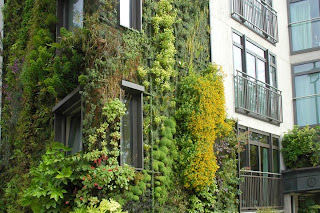There has been quite a fair amount of publicity regarding vertical gardens of late, that is to say walls of buildings upon which plants are growing in profusion as a result of a careful preparation and planning, as opposed to some ignoble edifice that has been shrouded in ivy or creeping ficus. I, for one, had never actually encountered such a garden in person, so I was quite delighted to see one up close during my visit to London. My girlfriend and I were walking along Piccadilly towards Hyde Park, passing many world famous institutions such as The Royal Academy of Art, which is also home to the Linnaean Society, the Ritz-Carlton, Fortnum & Masons (grocers to the Royal Family for eons; purveyors of fine comestible products no doubt!), the Japanese Embassy and the Hard Rock Cafe - the very first one, the original. Actually, just before we got to the Hard Rock, we saw this wonderfully dense planting outside of the Athenaeum hotel, but only at eye-level. The surprise comes quite unexpectedly as one follows the viridian foliages ever skyward until one realises that the entire whole is not a few large plants reaching to the heavens,but rather a garden comprising many imdividual small plants consciously and selectively arranged on the outside walls of a hotel. The effect is quite uplifting, rather joyous and many endorphins are released into the brain as one jumps to the conclusion of how obvious, how beautifully simple and how necessary such gardens will be in the future. Even as we swallow up tracts of the countryside, we do create more surface area than previously existed, and this seems a tremendous way to put oxygen creating plant-life back into our urban developments.
 Like many great works of art and design, while the effect seems as though it would be childishly facile to achieve, closer examination reveals that this is a very complex organisation of intellectual ideas and physical assets, and which involves at least two incredibly powerful forces, namely water and gravity, that need to be accounted for.
Like many great works of art and design, while the effect seems as though it would be childishly facile to achieve, closer examination reveals that this is a very complex organisation of intellectual ideas and physical assets, and which involves at least two incredibly powerful forces, namely water and gravity, that need to be accounted for.The garden is the work of a Frenchman, Patrick Blanc, who has established several vertical gardens around the world, indoors as well as outdoors, and who has been able to combine his scientific pursuits, which included the study of cliff-bound plants, with his wonderful artistic expression. Close examination of the garden reveals that the walls are covered in thick felt that has been perforated with pockets comprising six inch slits in the material. I imagine that prior to planting it would resemble an enormous paper towel of Claes Oldenburg proportions. Each plant is tucked into a pocket, and the whole is fed by drip irrigation when necessary, as I imagine the wall enjoys the English precipitation fairly regularly. In effect, the plants are growing hydroponically in a sterile substrate, although I have to imagine over time that the wall will become home to a dense quilt of decaying matter, wind born soil and dust, that will eventually become a quite fertile medium.
 The selection of plants is mostly made up of ones that have decorative foliage, as well as a propensity for this type of environment, and includes a fair number of pileas that require very little soil and whose root stuctures tend to cling to surfaces, rather than penetrate them. There are several begonias, and four exotic impatiens, one if which is the bright yelow and orange cascade that is in a few if the images. There are appear to be one if not two types of heuchera, but I am not sure if these are intruders as they are not listed on the offical plant list.
The selection of plants is mostly made up of ones that have decorative foliage, as well as a propensity for this type of environment, and includes a fair number of pileas that require very little soil and whose root stuctures tend to cling to surfaces, rather than penetrate them. There are several begonias, and four exotic impatiens, one if which is the bright yelow and orange cascade that is in a few if the images. There are appear to be one if not two types of heuchera, but I am not sure if these are intruders as they are not listed on the offical plant list. One does wonder, though, as to how the plants in the upper reaches of the garden are maintained, cut back, pruned and so forth. I suspect this needs a professional crew in a cherry-picker and this in itself may restrain amateur projects of a similar nature in the future. However, buildings of one or two stories, which seem to predominate in current urban landscapes are easily within the scope of an enterprising urban gardener.
I must say that the encounter with this wall was very uplifting and and reminds me that there is much to be optimistic about for the future of the planet, even as the BP catastrophe spews forth into the gulf, and provides much food for thought.






No comments:
Post a Comment